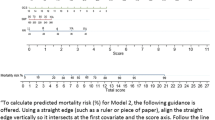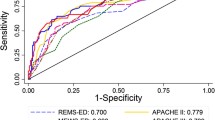Abstract
Objective: To customize the Acute Physiology and Chronic Health Evaluation (APACHE) III mortality equation for Spanish admissions to the intensive care unit (ICU) and evaluate its discrimination and calibration.
Design: Prospective multicenter inception cohort study.
Setting: 86 ICUs located in all regions of Spain.
Patients: 10 929 adult patients selected by a systematic sampling method. All types of critical care patients were included, including coronary bypass patients, but excluding those with burn injury, those admitted for pacemaker implants, patients under 16 years of age, and patients with length of ICU stay <6h.
Measurements and results: Data collection in the first 24 h after patient admission included: APACHE III score, treatment location prior to ICU admission, and main ICU admission diagnosis. Using these variables, a model for predicting hospital mortality was constructed, adapted to Spain, and its discriminating ability was assessed by the area below the ROC curve, which was 0.83. The model was validated using the jac-knife method and the area below the receiver operating characterisitic (ROC) curve for the cross-validated predictions was 0.82. The percentage of patients correctly classified at 0.50 risk of death was 82.3 %. Model calibration was evaluated by analysis of the agreement between the observed and cross-validated predicted mortality using the Hosmer-Lemeshow test, which gave a value of (H) 12.27, with no statistical significance, i. e., good calibration.
Conclusions: We have customized the APACHE III mortality prediction system for the Spanish population. This adapted model has demonstrated the requisite validation, calibration, and discrimination for its use among Spanish critical care patients.
Similar content being viewed by others
References
Knaus WA, Wagner DP, Draper EA, Zimmerman JE, Bergner M, Bastos PG, Sirio CA, Murphy DJ, Lotring T, Damiano A, Harrell FE (1991) The APACHE III prognostic system. Risk prediction of hospital mortality for critically ill hospitalized adults. Chest 100: 1619–1636
Le Gall JR; Lemeshow S; Saulnier F (1993) A new simplified acute physiology score (SAPS II) based on a European/North American multicenter study. JAMA 270: 2957–2963
Lemeshow S, Teres D, Klar J, Avrunin JS, Gehlbach SH, Rapoport J (1993) Mortality probability models (MPM II) based on an international cohort of Intensive care unit patients. JAMA 270: 2478–2486
Becker RB, Zimmerman JE (1996) ICU scoring systems allow prediction of patients outcomes and comparison of ICU performance. Crit Care Clin 12:503–514
Turner JS, Mudaliar YM, Chang RWS, Morgan CJ (1991) Acute physiology and chronic health evaluation (APACHE II) scoring in a cardio-thoracic intensive care unit. Crit Care Med 19:1266–1269
Becker RB, Zimmerman JE, Knaus WA, Wagner DP, Sneff MG, Drapper EA, Higgins TL, Estafanous FG, Loop FD (1995) The use of APACHE III to evaluate ICU length of stay, resource use, and mortality after coronary bypass surgery. J Cardiovasc Surg 36:1–11
Fedullo AJ, Swinburne AJ, Wahl GW, Bixby KR (1988) APACHE II score and mortality in respiratory failure due to cardiogenic pulmonary edema. Crit Care Med 16:1218–1221
Hopefl AW, Taaffe CL, Herrman VM (1989) Failure of APACHE II alone as a predictor of mortality in patients receiving total parenteral nutrition. Crit Care Med 17: 414–417
Cerra FB, Negro F, Abrams J (1990) APACHE II score does not predict multiple organ failure or mortality in postoperative surgical patients. Arch Surg125:519–522
McAnena OJ, Moore FA, Moore EE, Mattox KL, Marx JA, Pepe P (1992) Invalidation of the APACHE II scoring system for patients with acute trauma. J Trauma 33: 504–506
Rowan KM, Kerr JH, Major E, McPherson K, Short A, Vessey MP (1993) Intensive care society’s APACHE II study in Britain and Ireland. II Outcomes comparisons of intensive care units after adjustment for case mix by the American APACHE II method. BMJ 307: 977–981
Beck DH, Taylor BL, Millar B, Smith GB (1997) Prediction of outcome from intensive care: a prospective cohort study comparing Acute physiology and chronic health evaluation II and III prognostic system in a United Kingdom intensive care unit. Crit Care Med 25: 9–15
Bastos PG, Sun X, Wagner DP, Knaus WA, Zimmerman JE (1996) Application of the APACHE III prognostic system in Brazilian intensive care units: a prospective multicenter study. Intensive Care Med 22: 564–570
Moreno R, Morais P (1997) Outcome prediction in intensive care: results of a prospective, multicentre, Portuguese study. Intensive Care Med 23:177–186
Wong DT, Crofts SL, Gomez M, Mc Guire GP, Byrick RJ (1995) Evaluation of predictive ability of APACHE II system and hospital outcome in Canadian intensive care unit patients. Crit Care Med 23:1177–1183
Teik E, Hutchinson R, Short S, Buckley T, Lin E, Leung D (1993) Verification of the acute physiology and chronic health evaluation scoring system in a Hong Kong intensive care unit. Crit Care Med 21: 698–705
Zimmerman JE, Knaus WA, Judson JA, Havill JH, Trubuhovich RV, Drapper EZ, Wagner DP (1988) Patient selection for intensive care: a comparison of New Zealand and United States hospitals. Crit Care Med 16: 318–326
Knaus WA, Wagner DG, Zimmerman JE, Draper EA (1993) Variations in mortality and length of stay in intensive care units. Ann Inter Med 118: 753–761
Vázquez G, Rosado JL, Cerda M, Galdos P, Pino IL, Varo J, Aguayo E (1993) Estudio Multicentrico “Proyecto de analisis epidemilogico de los enfermos criticos” (PAEEC). Med Intensiva 17: 47–70
Vázquez Mata G, Murillo Cabezas F, Aguayo de Hoyos E (1992) Medicina Intensiva y garantías de calidad. Documento Carmona 1991. Med Intensiva 16: 65–68
Hanley JA, Mcneil BJ (1982) The meaning and use of the area under a receiver operating characteristics (ROC) curve. Radiology 143: 29–36
Miller RG (1974) The jacknife — a review. Biometrika 61:1–15
Author information
Authors and Affiliations
Rights and permissions
About this article
Cite this article
Rivera-Fernández, R., Vázquez-Mata, G., Bravo, M. et al. The apache III prognostic system: customized mortality predictions for Spanish ICU patients. Intensive Care Med 24, 574–581 (1998). https://doi.org/10.1007/s001340050618
Received:
Accepted:
Issue Date:
DOI: https://doi.org/10.1007/s001340050618




